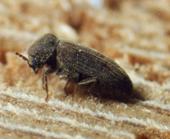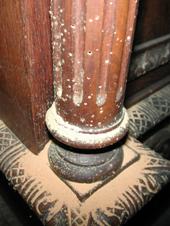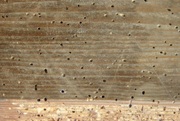Common furniture beetle (Anobium punctatum)
The common furniture beetle (also known as the woodworm beetle) belongs to the Anobiidae family, a group of insects which includes some of the most dangerous timber pests.
Economically speaking, the beetle that does the most damage in this family is the common furniture beetle. It attacks almost all wood types, though furniture and other wooden objects, like banisters, panelling, floor boards or skirting boards are particularly at risk.
How does it look like?
The common furniture beetle is dark brown or black and 3to 4 mm long. In the final stage, the larvae are 4 to 6 mm long and 1 to 2 mm thick. They are cream coloured and have three pairs of short legs at the head end.
How does it attack the wood?
The real wood destroyers are the larvae of the common furniture beetle. During their 2 – 3 year development phase, they gnaw frass galleries into the wood that are loosely filled with bore dust and faecal residues. Small piles of bore dust are sure signs of active infestation.
At the end of the development phase, the larvae pupate and the beetles hatch in the months between April and August. To emerge from the wood, they gnaw exit holes in the surface layer of about 1 – 2 mm in diameter.
The adult beetles only live for a few weeks and eat no food in this time. After mating, the females lay their eggs in wood cracks or in old exit holes. After approximately two weeks, the larvae hatch and bore their way into the wood.
What damage can they do?
Although the diameter of the frass galleries is relatively small, extensive and long-lasting infestation by common furniture beetles can lead to the complete destruction of wooden objects. This is due largely to the beetle’s tendency to lay its eggs in the same place on already infested wood. The larvae develop particularly well in damp wood, making objects in cellars or damp ground floor rooms much more vulnerable than those in heated rooms.
How can infestation be remedied?
Infestation by the common furniture beetle is treated by soaking or injecting the wood with effective curative preservatives, which also achieves a certain level of protection against renewed attack.
Heat treatment and fumigation are also possible treatment methods, though their lack of any protection against renewed infestation makes subsequent preventive treatment with an appropriate wood preservative necessary.



